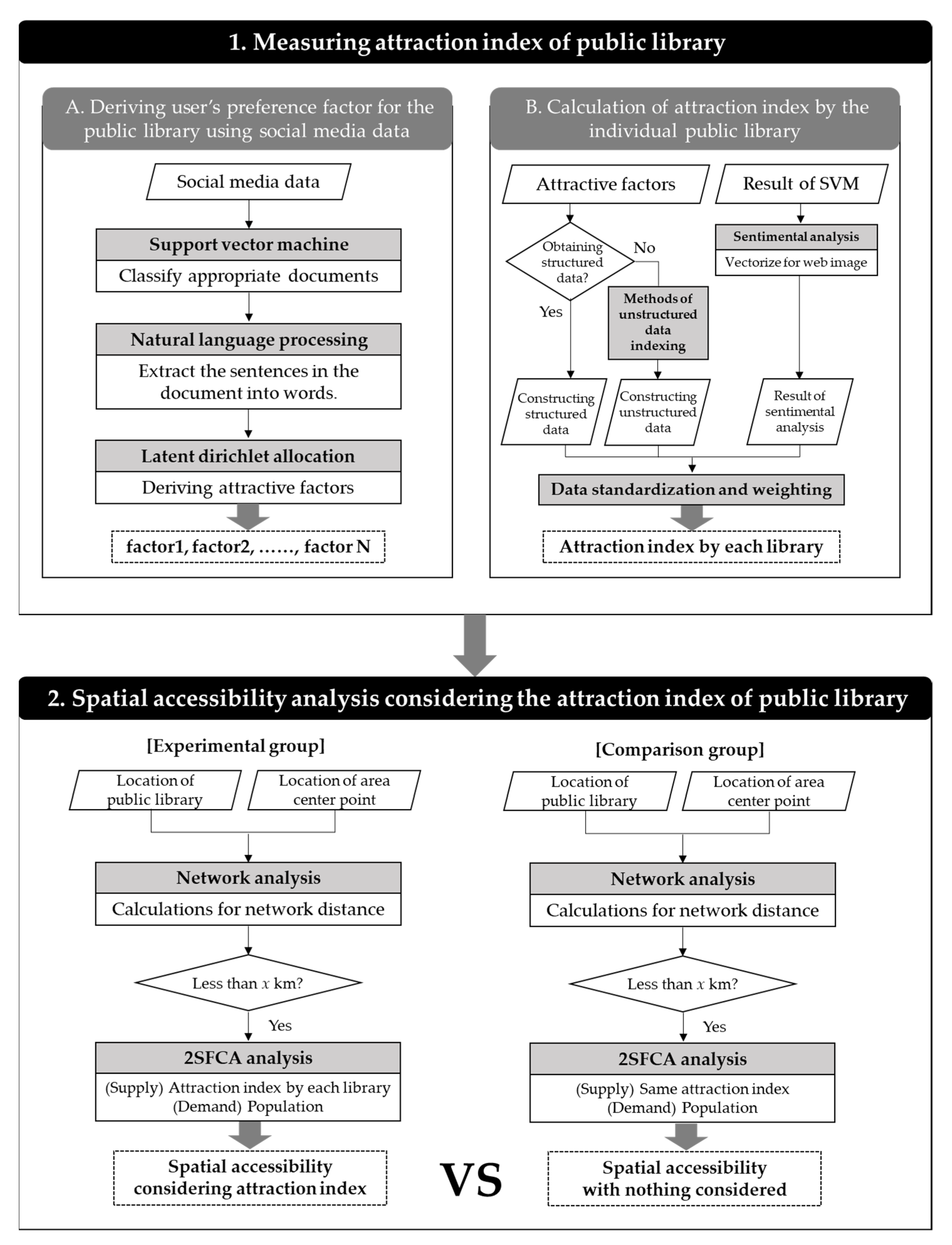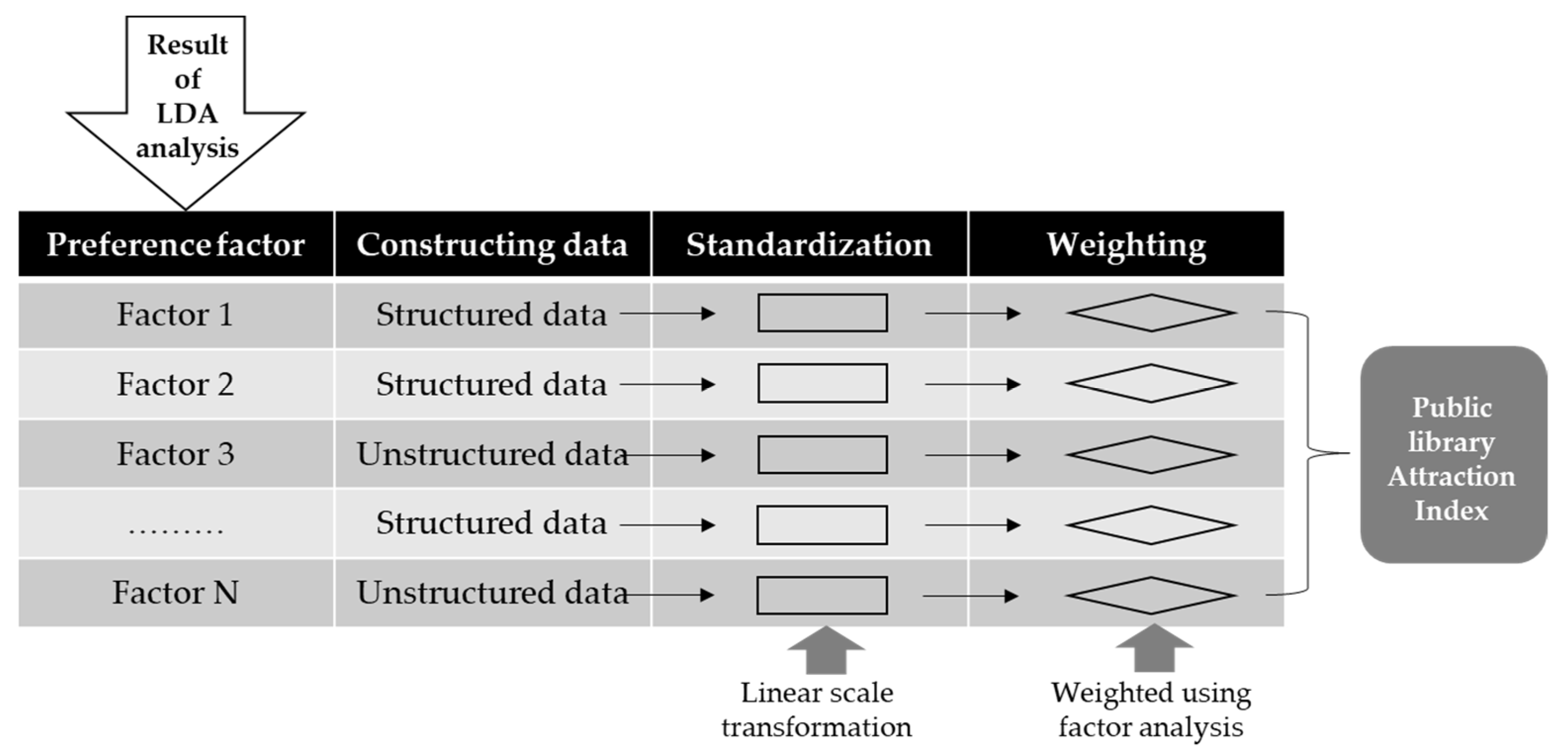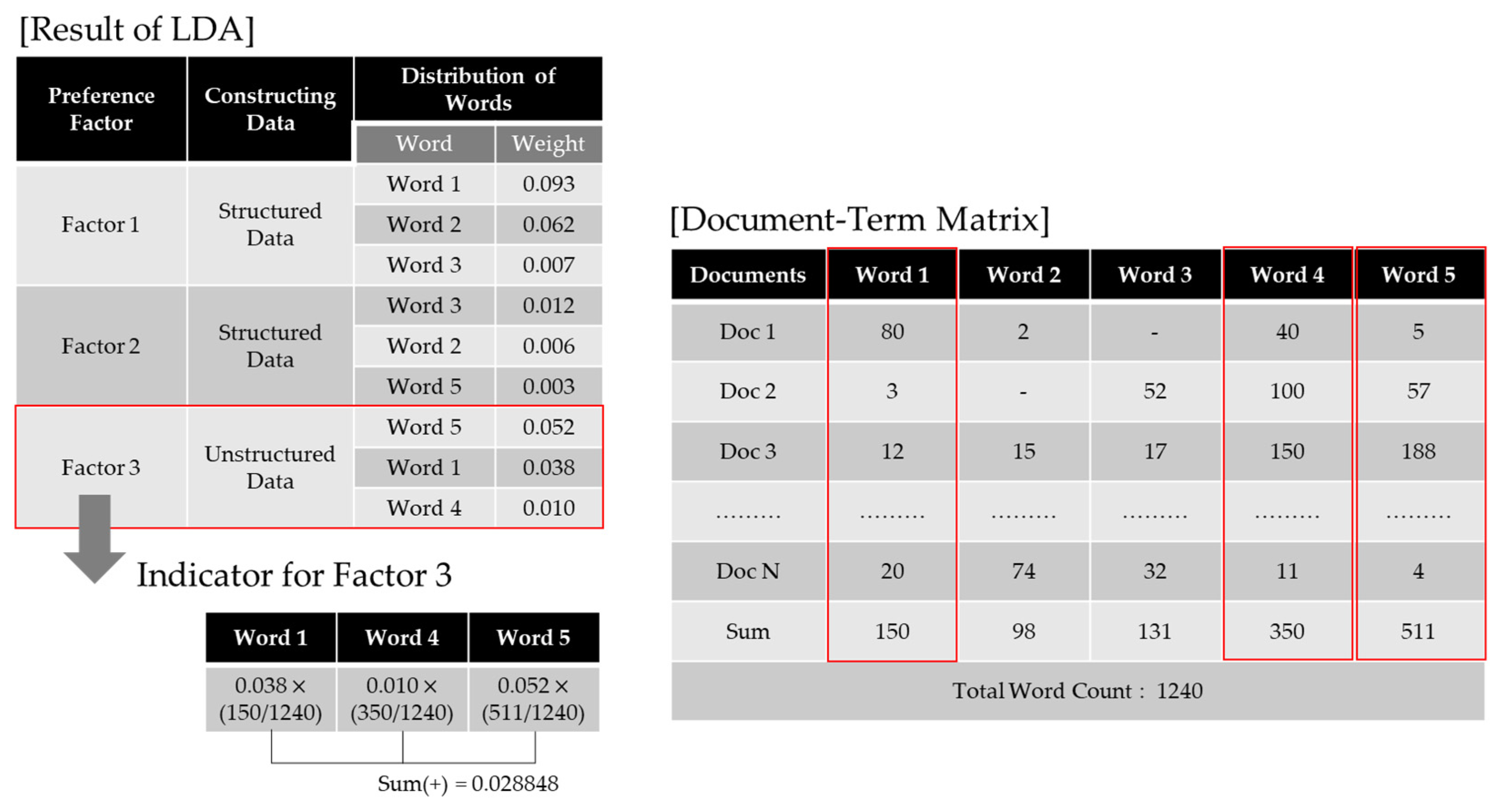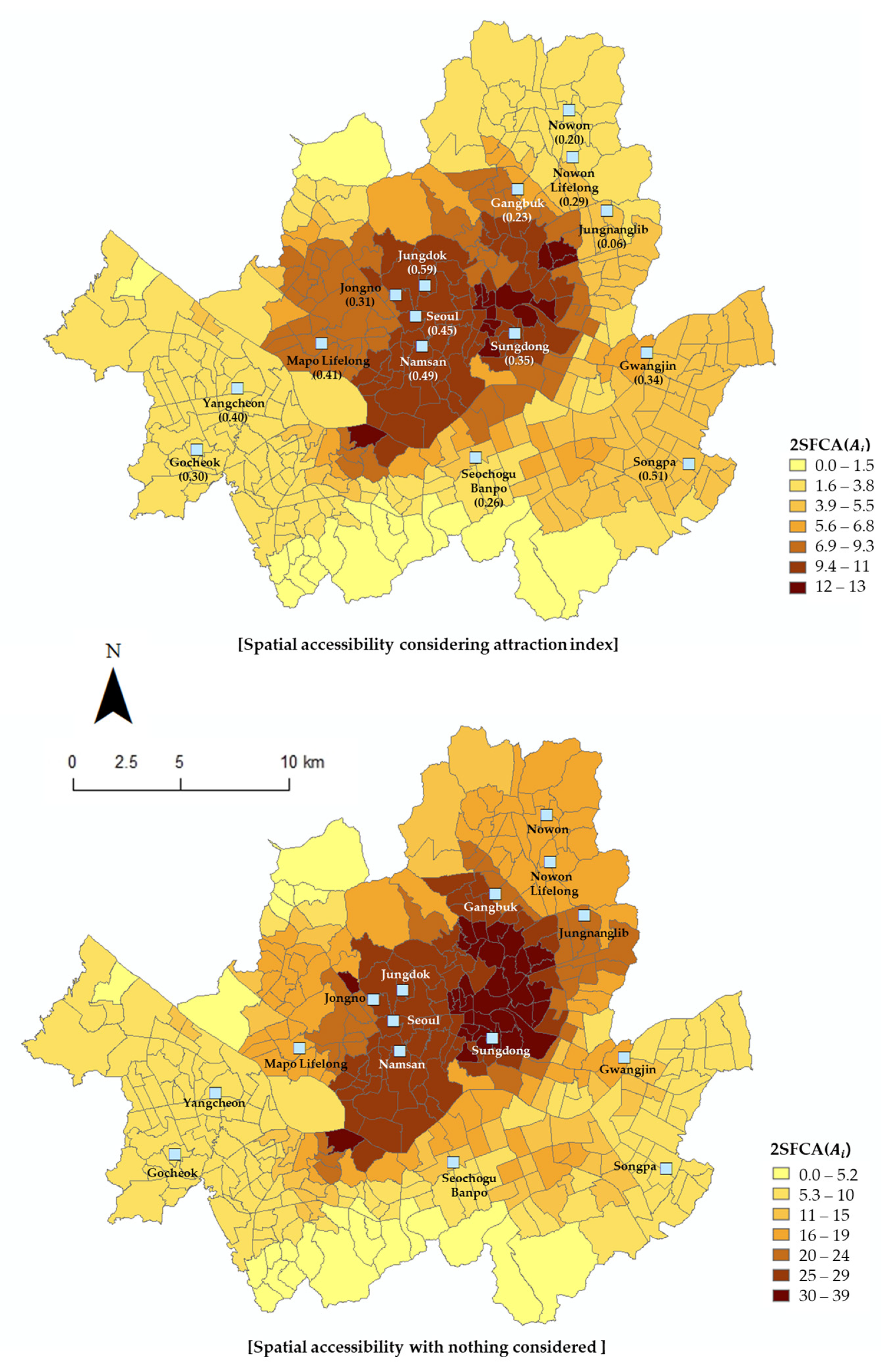An Analysis of Spatial Accessibility Changes According to the Attractiveness Index of Public Libraries Using Social Media Data
Abstract
:1. Introduction
2. Literature Review
3. Dataset and Method
3.1. Study Area and Data Collection
3.2. Measuring the Attraction Index of a Public Library
3.2.1. Deriving the User’s Preference Factor for the Public Library Using LBSM
3.2.2. Calculation of the Attraction Index for the Individual Public Library
Method for the Construction of Indicators According to Preference Factors
Construction of Indicators Using Unstructured Data
Public Library Image Based on Sentiment Analysis
Data Standardization and Weighting
3.3. Spatial Accessibility Analysis Based on the Attraction Index of Public Libraries
4. Results and Discussion
4.1. Analysis of the User’s Preference Factor of Public Libraries in Seoul, ROK
4.2. Analysis of the Attractiveness Index of Public Libraries in Seoul, ROK
4.3. Differences between the Original Accessibility and the Accessibility Based on the Attractiveness Index
5. Conclusions
5.1. The Accessibility Based on Attraction Index
5.2. Limitations and Future Directions
Author Contributions
Funding
Institutional Review Board Statement
Informed Consent Statement
Data Availability Statement
Conflicts of Interest
References
- Hertel, K.; Sprague, N. GIS and census data: Tools for library planning. Libr. Hi Tech. 2007, 25, 246–259. [Google Scholar] [CrossRef]
- Higgs, G.; Langford, M.; Fry, R. Investigating variations in the provision of digital services in public libraries using network-based GIS models. Libr. Inf. Sci. Res. 2013, 35, 24–32. [Google Scholar] [CrossRef]
- Soheili, F.D.K.; Khasseh, A.; Amini, M.; Rahimi, S. Investigating the rejuvenation of the children section of public libraries to enhance the attracton of user. Libr. Philos. Pract. 2019, 1–20. Available online: https://digitalcommons.unl.edu/libphilprac/2308 (accessed on 10 August 2021).
- Cole, K.J.G.; Gatrell, A.C. Public libraries in Salford: A geographical analysis of provision and access. Environ. Plan. A 1986, 18, 253–268. [Google Scholar] [CrossRef]
- Hawkins, A.M. Geographical Information Systems (GIS): Their use as decision support tools in public libraries and the integration of GIS with other computer technology. New Libr. World 1994, 95, 4–13. [Google Scholar] [CrossRef]
- Higgs, G.; Jones, S.; Langford, M.; Heley, J. Assessing the impacts of changing public service provision on geographical accessibility: An examination of public library provision in Pembrokeshire, South Wales. Environ. Plan. C Politics Space 2017, 36, 548–568. [Google Scholar] [CrossRef] [Green Version]
- Kinikin, J. Applying geographic information systems to the Weber County library system. Inf. Technol. Libr. 2004, 23, 102–107. [Google Scholar]
- Ottensmann, J.R. Evaluating equity in service delivery in library branches. J. Urban Aff. 1994, 16, 109–123. [Google Scholar] [CrossRef]
- Park, S.J. Measuring public library accessibility: A case study using GIS. Libr. Inf. Sci. Res. 2012, 34, 13–21. [Google Scholar] [CrossRef]
- Guo, Y.; Chan, C.H.; Yip, P.S.F. Spatial variation in accessibility of libraries in Hong Kong. Libr. Inf. Sci. Res. 2017, 39, 319–329. [Google Scholar] [CrossRef]
- Zhu, R.; Zhang, X.; Kondor, D.; Santi, P.; Ratti, C. Understanding spatio-temporal heterogeneity of bike-sharing and scooter-sharing mobility. Comput. Environ. Urban Syst. 2020, 81, 101483. [Google Scholar] [CrossRef]
- Lee, J.W.; Yu, K.Y.; Kim, J.Y. Accessibility analysis method based on public facility attraction index using SNS data. J. Korean Soc. Surv. Geod. Photogramm. Cartogr. 2019, 37, 29–42. (In Korean) [Google Scholar] [CrossRef]
- Donnelly, F.P. Regional variations in average distance to public libraries in the United States. Libr. Inf. Sci. Res. 2015, 37, 280–289. [Google Scholar] [CrossRef]
- Dummer, T.J. Health geography: Supporting public health policy and planning. Can. Med. Assoc. J. 2008, 178, 1177–1180. [Google Scholar] [CrossRef] [Green Version]
- Ni, J.; Liang, M.; Lin, Y.; Wu, Y.; Wang, C. Multi-mode Two-Step Floating Catchment Area (2SFCA) method to measure the potential spatial accessibility of healthcare services. ISPRS Int. J. Geo-Inf. 2019, 8, 236. [Google Scholar] [CrossRef] [Green Version]
- Wan, N.; Zou, B.; Sternberg, T. A three-step floating catchment area method for analyzing spatial access to health services. Int. J. Geogr. Inf. Sci. 2012, 26, 1073–1089. [Google Scholar] [CrossRef]
- Luo, J. Integrating the huff model and floating catchment area methods to analyze spatial access to healthcare services. Trans. GIS 2014, 18, 436–448. [Google Scholar] [CrossRef]
- Bryant, J.; Delamater, P.L. Examination of spatial accessibility at micro- and macro-levels using the enhanced two-step floating catchment area (E2SFCA) method. Ann. GIS 2019, 25, 219–229. [Google Scholar] [CrossRef] [Green Version]
- Wang, D.; Qiao, C.; Liu, S.; Wang, C.; Yang, J.; Li, Y.; Huang, P. Assessment of spatial accessibility to residential care facilities in 2020 in Guangzhou by small-scale residential community data. Sustainability 2020, 12, 3169. [Google Scholar] [CrossRef] [Green Version]
- Mao, L.; Nekorchuk, D. Measuring spatial accessibility to healthcare for populations with multiple transportation mode. Health Place 2013, 24, 115–122. [Google Scholar] [CrossRef]
- Langford, M.; Higgs, G.; Fry, R. Multi-modal two-step floating catchment area analysis of primary healthcare accessibility. Health Place 2016, 38, 70–81. [Google Scholar] [CrossRef]
- Li, Y.; Lin, Y.; Geertman, S.; Hooimeijer, P.; Xu, W. Accessibility-based equity of public facilities: A case study in Xiamen, China. Appl. Spat. Anal. Policy 2021. [Google Scholar] [CrossRef]
- Tao, Z.; Cheng, Y.; Liu, J. Hierarchical two-step floating catchment area (2SFCA) method: Measuring the spatial accessibility to hierarchical healthcare facilities in Shenzhen, China. Int. J. Equity Health 2020, 19, 164. [Google Scholar] [CrossRef]
- Cheng, Y.; Wang, J.; Rosenberg, M.W. Spatial access to residential care resources in beijing, China. Int. J. Health Geogr. 2012, 11, 32–42. [Google Scholar] [CrossRef] [Green Version]
- Delmelle, C.; Delmelle, E. Re-conceptualizing accessibility to parks in multi-modal cities: A variable-width floating catchment area (VFCA) method. Landsc. Urban Plan. 2015, 143, 90–99. [Google Scholar] [CrossRef]
- Rigolon, A. Parks and young people: An environmental justice study of park proximity, acreage, and quality in Denver, Colorado. Landsc. Urban Plan. 2017, 165, 73–83. [Google Scholar] [CrossRef]
- Xing, L.; Liu, Y.; Wang, B.; Wang, Y.; Liu, H. An environmental justice study on spatial access to parks for youth by using an improved 2SFCA method in Wuhan, China. Cities 2020, 96, 102405. [Google Scholar] [CrossRef]
- Bozorgi, P.; Eberth, J.M.; Eidson, J.P.; Porter, D.E. Facility Attractiveness and Social Vulnerability Impacts on Spatial Accessibility to Opioid Treatment Programs in South Carolina. Int. J. Environ. Res. Public Heath 2021, 18, 4246. [Google Scholar] [CrossRef] [PubMed]
- Lee, T.; Hong, T. Integrated sentiment classification model using SVM+ MTL: Application to the customer review of online store. Entrue J. Inf. Technol. 2017, 16, 81–95. Available online: https://kiss.kstudy.com/thesis/thesis-view.asp?key=3543588 (accessed on 10 August 2021).
- Bae, J.H.; Son, J.E.; Song, M. Analysis of twitter for 2012 South Korea presidential election by text mining techniques. J. Intell. Inf. Syst. 2013, 19, 141–156. [Google Scholar] [CrossRef]
- Blei, D.M. Probabilistic topic models. Commun. ACM 2012, 55, 77–84. [Google Scholar] [CrossRef] [Green Version]
- Appel, O.; Chiclana, F.; Carter, J. Main concepts, state of the art and future research questions in sentiment analysis. Acta Polytech. Hung. 2015, 12, 87–108. [Google Scholar] [CrossRef]
- Ferguson, P.; O’Hare, N.; Davy, M.; Bermingham, A.; Sheridan, P.; Gurrin, C.; Smeaton, A.F. Exploring the use of paragraph-level annotations for sentiment analysis of financial blogs. In Proceedings of the WOMAS 209-Workshop on Opinion Mining and Sentiment Analysis, Seville, Spain, 13 November 2009; Available online: http://sites.google.com/site/womsa09/ (accessed on 10 August 2021).
- Lochter, J.V.; Zanetti, R.F.; Reller, D.; Almeida, A.T. Short text opinion detection using ensemble of classifiers and semantic indexing. Expert Syst. Appl. 2016, 62, 243–249. [Google Scholar] [CrossRef]
- Pak, A.; Paroubek, P. Twiter as a corpus for sentiment analysis and opinion mining. In Proceedings of the Seventh International Conference on Language Resources and Evaluation (LREC’10), Valletta, Malta, 17–23 May 2010; Available online: http://www.lrec-conf.org/proceedings/lrec2010/pdf/385_Paper.pdf (accessed on 10 August 2021).
- Pang, B.; Lee, L.; Vaithyanathan, S. Thumbs up? Sentiment Classification using Machine Learning Techniques. In Proceedings of the 2002 Conference on Empirical Methods in Natural Language Processing (EMNLP 2002), University of Pennsylvania, Philadelphia, PA, USA, 6–7 July 2002. [Google Scholar] [CrossRef] [Green Version]
- Liu, B. Sentiment Analysis: Mining Opinions, Sentiments, and Emotions, 2nd ed.; Cambridge University Press: Cambridge, NY, USA, 2020. [Google Scholar]
- Basiri, M.E.; Ghasem-Aghaee, N.; Reza, A. Lexicon-based sentiment analysis in Persian. Curr. Future Dev. Artif. Intell. 2017, 1, 154–183. [Google Scholar] [CrossRef]
- Moraes, R.; Valiati, J.F.; Neto, W.P.G. Document-level sentiment classification: An empirical comparison between SVM and ANN. Expert Syst. Appl. 2013, 40, 621–633. [Google Scholar] [CrossRef]
- Xu, J.; Danlu, C.; Qiu, X.; Huang, X. Cached long short-term memory neural networks for document-level sentiment classification. In Proceedings of the 2016 Conference on Empirical Methods in Natural Language Processing (EMNLP 2016), Austin, TX, USA, 1–4 November 2016. [Google Scholar] [CrossRef] [Green Version]
- Chatterjee, A.; Gupta, U.; Chinnakotla, M.K.; Srikanth, R.; Galley, M.; Agrawal, P. Understanding emotions in text using deep learning and big data. Comput. Hum. Behav. 2019, 93, 309–317. [Google Scholar] [CrossRef]
- Zhou, X.; Wan, X.; Xiao, J. Attention-based LSTM network for cross-lingual sentiment classification. In Proceedings of the EMNLP 2016-Conference on Empirical Methods in Natural Language Processing (EMNLP 2016), Austin, TX, USA, 1–4 November 2016. [Google Scholar] [CrossRef]
- He, R.; Lee, W.S.; Ng, H.T.; Dahlmeier, D. Exploiting document knowledge for aspect-level sentiment classification. In Proceedings of the 56th Annual Meeting of the Association for Computational Linguistics (Volume 2: Short Papers), Melbourne, Australia, 15–20 July 2018. [Google Scholar] [CrossRef] [Green Version]
- Rhanoui, M.; Mikram, M.; Yousfi, S.; Barzali, S. A CNN-BiLSTM model for document-level sentiment analysis. Mach. Learn. Knowl. Extr. 2019, 1, 832–847. [Google Scholar] [CrossRef] [Green Version]
- Basiri, M.E.; Nemati, S.; Abdar, M.; Cambria, E.; Acharya, U.R. ABCDM: An attention-based bidirectional CNN-RNN deep model for sentiment analysis. Future Gener. Comput. Syst. 2021, 115, 279–294. [Google Scholar] [CrossRef]
- Luo, W. Using a GIS-based floating catchment method to assess areas with shortage of physicians. Health Place 2004, 10, 1–11. [Google Scholar] [CrossRef]
- McGrail, M.R.; Humphreys, J.S. Measuring spatial accessibility to primary care in rural areas: Improving the effectiveness of the two-step floating catchment area method. Appl. Geogr. 2009, 29, 533–541. [Google Scholar] [CrossRef]
- MCST. A Manual on Construction and Management for Public Libraries; MCST: Sejong-si, Korea, 2019. (In Korean) [Google Scholar]





| Topic | Extraction of Words (Word Weight) | ||||
|---|---|---|---|---|---|
| Surrounding environment | Photo (0.012) | Building (0.007) | Person (0.006) | Café (0.006) | Cherry blossom (0.006) |
| Facilities and usage scale | Library (0.115) | Use (0.018) | Humanity (0.015) | Reading room (0.013) | Facility (0.011) |
| Cultural Program | Culture (0.012) | Citizen (0.011) | Exhibition (0.010) | Space (0.010) | Program (0.009) |
| Childcare | Children (0.016) | Time (0.014) | Thinking (0.014) | Person (0.012) | Mom (0.008) |
| Books and materials | Library (0.019) | Reading (0.016) | Reference room (0.014) | Material (0.013) | Information (0.012) |
| Public Library | Surrounding Environment Indicator | Number of Seats | Number of Cultural Program Courses | Childcare Indicator | Number of Reference Room Users | Public Library Image Indicator |
|---|---|---|---|---|---|---|
| Songpa | 1.57 | 1176 | 100 | 4.95 | 1,293,101 | 45,297.76 |
| Jungnangulib | 0.33 | 600 | 47 | 2.55 | 1,449,119 | 42,480.39 |
| Yangcheon | 0.92 | 1612 | 45 | 3.97 | 1,312,345 | 41,686.62 |
| Mapo Lifelong | 0.87 | 885 | 285 | 4.06 | 805,628 | 68,051.67 |
| Jungdok | 2.99 | 1080 | 85 | 4.12 | 958,385 | 222,740.88 |
| Sungdong | 0.64 | 558 | 124 | 4.13 | 1,332,501 | 61,011.64 |
| Nowon | 0.90 | 685 | 24 | 2.94 | 619,902 | 31,131.63 |
| Gangbuk | 0.80 | 524 | 64 | 2.74 | 1,189,979 | 38,211.92 |
| Nowon Lifelong | 0.76 | 853 | 327 | 2.83 | 937,546 | 19,109.44 |
| Gwangjin | 0.93 | 949 | 117 | 2.65 | 1,286,599 | 36,036.87 |
| Seochogu Banpo | 0.76 | 450 | 66 | 4.58 | 914,436 | 22,280.68 |
| Namsan | 1.67 | 1303 | 70 | 3.98 | 825,933 | 244,001.84 |
| Gocheok | 0.82 | 665 | 49 | 3.36 | 926,555 | 53,850.56 |
| Jongno | 1.02 | 506 | 30 | 3.45 | 532,553 | 38,795.49 |
| Seoul | 1.36 | 390 | 1 | 3.82 | 1,148,307 | 382,731.10 |
| Name of Indicator | Indicator A 1 | Indicator B 2 | Indicator C 3 | Indicator D4 | Indicator E 5 | Indicator F 6 |
|---|---|---|---|---|---|---|
| Indicator A 1 | 1 | 0.397 | −0.122 | 0.437 | 0.034 | 0.593 |
| Indicator B 2 | 0.397 | 1 | 0.156 | 0.283 | −0.308 | 0.012 |
| Indicator C 3 | −0.122 | 0.156 | 1 | −0.028 | −0.407 | −0.279 |
| Indicator D 4 | 0.437 | 0.283 | −0.028 | 1 | 0.122 | 0.251 |
| Indicator E 5 | 0.034 | −0.308 | −0.407 | 0.122 | 1 | 0.075 |
| Indicator F 6 | 0.593 | 0.012 | −0.279 | 0.251 | 0.075 | 1 |
| Component | Initial Eigenvalues | Extraction Sums of Squared Loadings | Rotation Sums of Squared Loadings | ||||||
|---|---|---|---|---|---|---|---|---|---|
| Total | % of Variance | Cumulative % | Total | % of Variance | Cumulative % | Total | % of Variance | Cumulative % | |
| 1 | 2.070 | 34.507 | 34.507 | 2.070 | 34.507 | 34.507 | 2.062 | 34.361 | 34.361 |
| 2 | 1.642 | 27.371 | 61.878 | 1.642 | 27.371 | 61.878 | 1.651 | 27.517 | 61.878 |
| 3 | 0.855 | 14.243 | 76.121 | ||||||
| 4 | 0.685 | 11.421 | 87.542 | ||||||
| 5 | 0.482 | 8.036 | 95.578 | ||||||
| 6 | 0.265 | 4.422 | 100.000 | ||||||
| Name of Indicator | Factor 1 | Factor 2 | Communality | Weight_1 | Weight_2 |
|---|---|---|---|---|---|
| Surrounding environment indicator | 0.891 | 0.006 | 0.793917 | 27.13319 | 0.213920 |
| Number of seats | 0.517 | 0.610 | 0.639389 | 21.85198 | 0.172282 |
| Number of cultural program courses | −0.200 | 0.750 | 0.602500 | 20.59125 | 0.162343 |
| Childcare indicator | 0.682 | 0.031 | 0.466085 | 15.92908 | 0.125586 |
| Number of reference room users | 0.038 | −0.784 | 0.616100 | 21.05605 | 0.166007 |
| Public library image indicator | 0.702 | −0.317 | 0.593293 | 20.27659 | 0.159862 |
| SUM | 2.630 | 0.296 | 1 |
| Public Library | Index A 1 | Index B 2 | Index C 3 | Index D 4 | Index E 5 | Index F 6 | Attraction Index |
|---|---|---|---|---|---|---|---|
| Songpa | 0.10 | 0.11 | 0.05 | 0.13 | 0.11 | 0.01 | 0.51 |
| Jungnangulib | 0.00 | 0.03 | 0.02 | 0.00 | 0.00 | 0.01 | 0.06 |
| Yangcheon | 0.05 | 0.17 | 0.02 | 0.07 | 0.07 | 0.01 | 0.40 |
| Mapo Lifelong | 0.04 | 0.07 | 0.14 | 0.08 | 0.05 | 0.02 | 0.41 |
| Jungdok | 0.21 | 0.10 | 0.04 | 0.08 | 0.07 | 0.09 | 0.59 |
| Sungdong | 0.03 | 0.02 | 0.06 | 0.08 | 0.14 | 0.02 | 0.35 |
| Nowon | 0.05 | 0.04 | 0.01 | 0.02 | 0.07 | 0.00 | 0.20 |
| Gangbuk | 0.04 | 0.02 | 0.03 | 0.01 | 0.12 | 0.01 | 0.23 |
| Nowon Lifelong | 0.03 | 0.07 | 0.16 | 0.01 | 0.02 | 0.00 | 0.29 |
| Gwangjin | 0.05 | 0.08 | 0.06 | 0.01 | 0.14 | 0.01 | 0.34 |
| Seochogu Banpo | 0.04 | 0.01 | 0.03 | 0.11 | 0.08 | 0.00 | 0.26 |
| Namsan | 0.11 | 0.13 | 0.03 | 0.07 | 0.05 | 0.10 | 0.49 |
| Gocheok | 0.04 | 0.04 | 0.02 | 0.04 | 0.14 | 0.02 | 0.30 |
| Jongno | 0.06 | 0.02 | 0.01 | 0.05 | 0.17 | 0.01 | 0.31 |
| Seoul | 0.08 | 0.00 | 0.00 | 0.07 | 0.14 | 0.16 | 0.45 |
Publisher’s Note: MDPI stays neutral with regard to jurisdictional claims in published maps and institutional affiliations. |
© 2021 by the authors. Licensee MDPI, Basel, Switzerland. This article is an open access article distributed under the terms and conditions of the Creative Commons Attribution (CC BY) license (https://creativecommons.org/licenses/by/4.0/).
Share and Cite
Kim, J.; Lee, J. An Analysis of Spatial Accessibility Changes According to the Attractiveness Index of Public Libraries Using Social Media Data. Sustainability 2021, 13, 9087. https://doi.org/10.3390/su13169087
Kim J, Lee J. An Analysis of Spatial Accessibility Changes According to the Attractiveness Index of Public Libraries Using Social Media Data. Sustainability. 2021; 13(16):9087. https://doi.org/10.3390/su13169087
Chicago/Turabian StyleKim, Jiyoung, and Jiwon Lee. 2021. "An Analysis of Spatial Accessibility Changes According to the Attractiveness Index of Public Libraries Using Social Media Data" Sustainability 13, no. 16: 9087. https://doi.org/10.3390/su13169087
APA StyleKim, J., & Lee, J. (2021). An Analysis of Spatial Accessibility Changes According to the Attractiveness Index of Public Libraries Using Social Media Data. Sustainability, 13(16), 9087. https://doi.org/10.3390/su13169087






